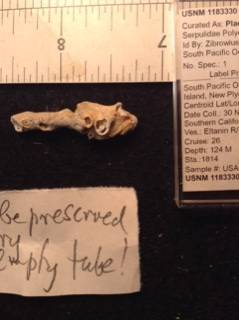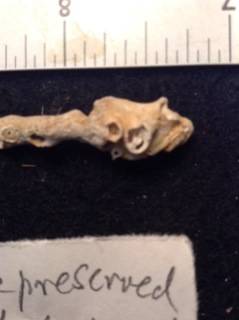Deep-Sea taxon details
Placostegus Philippi, 1844
129571 (urn:lsid:marinespecies.org:taxname:129571)
accepted
Genus
- Species Placostegus assimilis McIntosh, 1885
- Species Placostegus tridentatus (Fabricius, 1779)
- Species Placostegus morchii McIntosh, 1885 accepted as Protoplacostegus morchii (McIntosh, 1885) (superseded original combination)
- Species Placostegus benthalianus McIntosh, 1885 (uncertain > taxon inquirendum)
marine, brackish, fresh, terrestrial
recent + fossil
Philippi, A. (1844). Einige Bemerkungen über die Gattung Serpula, nebst Aufzählung der von mir im Mittelmeer mit dem Thier beobachteten Arten. <em>Archiv für Naturgeschichte, Berlin.</em> 10(1): 186-198, plate 6., available online at http://biodiversitylibrary.org/page/13704089 [details]
Deep-Sea (2024). Placostegus Philippi, 1844. Accessed at: https://marinespecies.org/deepsea/aphia.php?p=taxdetails&id=129571 on 2024-04-19
Glover, A.G.; Higgs, N.; Horton, T. (2024). World Register of Deep-Sea species (WoRDSS). Placostegus Philippi, 1844. Accessed at: https://marinespecies.org/deepsea/aphia.php?p=taxdetails&id=129571 on 2024-04-19
Date
action
by
original description
Philippi, A. (1844). Einige Bemerkungen über die Gattung Serpula, nebst Aufzählung der von mir im Mittelmeer mit dem Thier beobachteten Arten. <em>Archiv für Naturgeschichte, Berlin.</em> 10(1): 186-198, plate 6., available online at http://biodiversitylibrary.org/page/13704089 [details]
basis of record Bellan, G. (2001). Polychaeta, <i>in</i>: Costello, M.J. <i>et al.</i> (Ed.) (2001). European register of marine species: a check-list of the marine species in Europe and a bibliography of guides to their identification. <em>Collection Patrimoines Naturels.</em> 50: 214-231. (look up in IMIS) [details]
additional source Fauchald, K. (1977). The polychaete worms, definitions and keys to the orders, families and genera. <em>Natural History Museum of Los Angeles County: Los Angeles, CA (USA), Science Series.</em> 28:1-188., available online at http://www.vliz.be/imisdocs/publications/123110.pdf [details]
redescription Hove, Harry A. ten.; Kupriyanova, Elena K. (2009). Taxonomy of Serpulidae (Annelida, Polychaeta): The state of affairs. <em>Zootaxa.</em> 2036: 1-126., available online at http://www.mapress.com/j/zt/issue/view/2173
page(s): 74 [details]
basis of record Bellan, G. (2001). Polychaeta, <i>in</i>: Costello, M.J. <i>et al.</i> (Ed.) (2001). European register of marine species: a check-list of the marine species in Europe and a bibliography of guides to their identification. <em>Collection Patrimoines Naturels.</em> 50: 214-231. (look up in IMIS) [details]
additional source Fauchald, K. (1977). The polychaete worms, definitions and keys to the orders, families and genera. <em>Natural History Museum of Los Angeles County: Los Angeles, CA (USA), Science Series.</em> 28:1-188., available online at http://www.vliz.be/imisdocs/publications/123110.pdf [details]
redescription Hove, Harry A. ten.; Kupriyanova, Elena K. (2009). Taxonomy of Serpulidae (Annelida, Polychaeta): The state of affairs. <em>Zootaxa.</em> 2036: 1-126., available online at http://www.mapress.com/j/zt/issue/view/2173
page(s): 74 [details]
 Present
Present  Inaccurate
Inaccurate  Introduced: alien
Introduced: alien  Containing type locality
Containing type locality
From editor or global species database
Diagnosis Tube triangular in cross-section, with denticulate keels, transparent or semi-transparent. Operculum inverse conical with chitinous cup-shaped endplate. Collar chaetae absent. ten Hove & Kupriyanova (2009) give a long diagnosis of which the stand-out character is that "Placostegus is one of three serpulid genera (see also Neomicrorbis and Vitreotubus) with an entirely vitreous tube; completely transparent, glass-like in live animals ..." Also, "Placostegus has one evident diagnostic autapomorphy—the belt of bright red ocelli in the region where in other genera collar-chaetae are found" [details]Editor's comment Morch (1863: 413, 418) tried to bring some order in what he perceived to be the genus Placostegus, distinguishing two sections: sectio alpha, characterized by a crystalline tube and "horny" operculum; sectio beta, characterized by a "cretaceous" tube and calcareous operculum. He, however, was not consistent in the application of these characters, so his division makes no sense in the present state of knowledge. Only one species, tridentatus, mentioned by Morch remains in the genus Placostegus, with what generally is regarded to be its synonym tricuspidatus, however, regarded by Mörch as a Mediterranean species as opposed to the Atlantic tridentatus; all other taxa have been referred to a variety of genera, Pomatoleios, Pomatoceros, Spirobranchus, but also Galeolaria, Bathyvermilia, Janita, Vermiliopsis and even maybe Hydroides. Nevertheless, the genus including subsequently described or resurrected species is badly in need of revision. [details]









